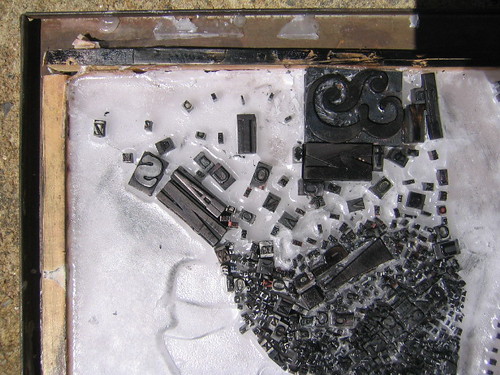Text is…by Tracy Gidinski
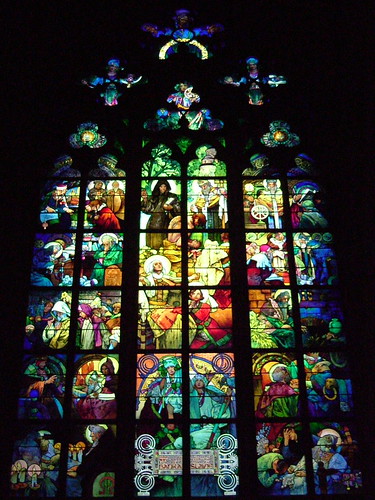
Prague – stained glass window, originally uploaded by thebevster.
This Mucha stained glass in St. Vitus’ Cathedral in Prague represents to me what text is. What I love about this stained glass is its modern take on a classic format. Instead of copying the style of the past when Mucha was asked to design it in the 1930’s, he wove history and the present day together to create something that represented both his history and his modern era. Likewise, text is the capturing of a culture at a given moment while simultaneously weaving in elements of that culture’s history.
Additionally, like Mucha’s stained glass techniques included modern technologies, making his images different than those of the past, new technologies add change and new shape to text.
Therefore, text and technology cannot be viewed as separate entities but as reflections of one another.
September 15, 2009 No Comments
(Im)movable type
Hi everyone! I’m Danielle, arriving a little late (from Fort Langley – I blame our very infrequent bus service) – and trying to figure out where everything is and get caught up.
I chose this photo because I love to work with clay, and one of my recent project ideas involves combining clay and metal type. So far I have experimented only with using type to make imprints in clay – sometimes to create words, and sometimes to create “non-words”. For example one of my fonts makes lovely fruit (capital O) and leaves (&) strung along a vine. I like the way that blurs the boundaries between word and image. Some day I may also play with incorporating the type itself into the clay – though I’m not sure what will happen when I fire it, and not sure I can bring myself to sacrifice any of my precious type to find out!
I am also very interested by the effect ‘writing’ in clay has on my relationship to words… I pick them very carefully (and frugally) when they will last for so long and lend their spirit to the character of the piece. What do these words mean, invoke, evoke… how might that be different for me than for someone else?
Okay, enough of that… me, and my interest in the course: I’m a SCPE student, in my first semester… have worked in post-secondary education (staff/admin) for 16 years… taking this course because I am very interested in how medium affects use of language, and also because much of my work in Institutional Research involves trying to get people to engage with me in writing (online, on paper) to tell me things I need to know.
September 15, 2009 No Comments
Technological System…

Web 2.0, originally uploaded by Rod Monkey.
“Technology is a system. It entails far more than its individual material components. Technology involves organization, procedures, symbols, new words, equations, and, most of all, a mindset.” (Franklin, p. 2-3)
Technology is more commonly perceived as any human-made object that does not occur naturally in nature, but often imitates more naturally occurring phenomena, and are often used to aid us in some fashion.
However, technology is ecological in that it doesn’t just add or subtract; as Postman puts it, “it changes everything” (Postman, 1992, p. 18). The printing press revolutionized our access to knowledge. Internet has changed our communications patterns.
Thus, technology is a system, inextricably linked to human life.
Hermia
References:
Franklin, U. (1999). The Real World of Technology. Toronto: Anansi.
Postman, N. (1992). Technopoly: the surrender of culture to technology. New York: Vintage Books.
September 15, 2009 No Comments
Summary of Community Weblog
When I initially begin to “surf” around the community Weblog, I was getting very frustrated. It was a feeling of chaos and clutter. I was looking to find some means of scaffolding my learning and to balance where I was and where I had to go. This blog is not, in my opinion, user friendly. I do not feel that this has aided in my learning, as I was feeling frustrated with my progress and my location. Upon reading the Summary page, I understood that the blog was created in a fashion that is disorienting; rather unfair to lead the students astray J
In the Community Weblog, the pages I enjoyed the most are those that appear different. The photos are unique, the style of writing deviates from the norm. Perhaps this is because I spend the bulk of my day looking at formal documents and I want to have something catch my interest.
Laurie
September 15, 2009 2 Comments
…..TEXT….is….
Text is…. Images and words….. bound together by some pattern….. that is understandable by a community…… that transcends time……. until it is discovered by another culture and then is researched and analyzed……. Text is what we create…… when we weave together thoughts…… to share ideas with others……. to create rules….. to create escapes…….. Text is not just words…… not just ideas….. not just symbols with meanings…… Text can define who we are…. where we are going…. how we got there……This is my idea of text.
September 15, 2009 No Comments
Technology is….

Balance Prime
The word technology is something that I struggle with often. I see technology as any tool that aids in the creation of some other object or allows work to be completed with some amount of ease. Consider a rock. If I use a rock to hit another person, it is now a weapon. If I use a rock to draw a picture on a cave wall, it is a tool. My perfered definition of technology is best described by Ursula Franklin in the CBC Massey Lectures. Franklin states “Like democracy, technology is a multifaceted entity. It includes activities as well as a body of knowledge, structures as well as the act of structuring.” (Franklin, 1999, p. 6) Franklin further defines technology as “practice…ways of doing something.” ((p.6) This ‘process of work’ can be categorized into two distinct spheres including holistic and prescriptive technologies. Holistic technologies can be equated to those events whereby the same individual envisions an idea, prepares the means to accomplish the idea, and results in an end product that was created from start to finish by one set of hands; a painting, a goblet, or writing on a cave wall. Prescriptive technologies can be best summed up by mass production, compliance to a standard and little to no deviation or creativity for the worker; Fordism or Military training
Franklin, Ursula. (1999) The Real World of Technology. (CBC Massey lectures series.) Concord, ON: House of Anansi Press Limited.
September 15, 2009 No Comments
Searching and sorting?
I’m new to blogging and I’ve got a question for anybody out there that has the expertise/time/interest to respond:
Is there a way to search for authors? I tried to find the posts that I had created and couldn’t seem to find an easy way to search or sort postings in order to find the ones that I had created.
September 15, 2009 2 Comments
Using the blogs
I’d like to comment on my experiences with using this blog so far. I’ve never worked in this medium until this week but can certainly compare it to a wiki, which I’ve been using in my class as well as to collaborate on course design.
First of all, I’ve enjoyed being able to read other posts. I could (and did) spend hours reading posts, discussion topics and generally playing with the buttons to familiarize myself with this environment. I told some of my coworkers earlier last week that I would just come home, turn on the laptop and the next thing I know I am in a world that exists only inside this window. And then I start to open more and more windows as I read, respond, research… well, I wouldn’t leave this spot until it was time for bed. And still, the ideas would dance in my mind to the point of keeping me awake long past my bedtime.
The ideas came from all the wonderful posts I read and wanted to add to. I’ve taken online courses before where the amount of research required kept us from reading other posts and perhaps saving some of the valuable resources other students might have discovered. In other words, time constraints kept us from benefiting from each others’ research.
I think the pace so far has allowed me to read and reflect. I am also enjoying the way I can work in a non-linear fashion. I can spend time reading blogs or posts on the discussion boards or following up on links that have been provided by other students. Or, I can be anti-social and go read my textbook.
It’s the social aspect of this medium that makes it so delightful and compelling. And thank goodness I don’t have to put on my boots come winter to go off to a campus.
On the downside, I have struggled with figuring out how to post to a certain page and have feared publishing a post and finding I did it all wrong only to not be able to delete it (ungrounded fears). I created my own blog last week for a space to experiment. That way I wouldn’t feel foolish if I made a mistake.
And I will let you in on a secret. One of the other students and I regularly talk on the phone or chat when we are unsure on how to proceed. But that is quickly turning into discussions on what we might research for our Module 4 project.
As for comparisons to a wiki, I think the wiki might be simpler to understand and set up. As such, it might be more suitable for my high school classes. When I tried the experiment last year with my grade 12s as an alternative to a group project and presentation, there was a lot of trepidation. I liked the wiki because it allowed me to see exactly who took part in the group work and when and how often they worked. I am not sure how that would work in a blog.
I will continue to investigate this blogging business and hopefully, I’ll be able to use this technology as comfortably as I have used Blackboard for online courses or wikis for class projects. For now, I just hope this publishes to the right page.
September 15, 2009 2 Comments
Text is….. meaningful
“I was working on the proof of one of my poems all the morning, and took out a comma. In the afternoon I put it back again.”
Oscar Wilde
Much like the intentions within this quote, text can be meaningful in brevity while subtle nuances can make significant adjustments. The beauty of text is that is can be manipulated in so many ways and infinite possibilities are afforded to any who choose to play with letters and words. Text is the vehicle by which authors assign meaning; the artifact in which we immortalize thoughts and facts; the unspoken representation by which we speak. Text is our tangible fingerprint crafted in written language.
September 15, 2009 No Comments
Technology is…. magic
Sir Arthur Clarke, co-author of 2001: A Space Odyssey, was a science fiction and otherwise “speculative fiction” author, inventor and “futurist”. He coined the three laws of prediction as follows:
- When a distinguished but elderly scientist states that something is possible, he is almost certainly right. When he states that something is impossible, he is very probably wrong.
- The only way of discovering the limits of the possible is to venture a little way past them into the impossible.
- Any sufficiently advanced technology is indistinguishable from magic.
The last two laws in particular represent a commentary on technology from my perspective. The notion of the impossible becoming possible; the notion of having to reach beyond what is currently afforded in order to truly see what we are capable of achieving; the notion that present innovations would have been considered magical in the past. Technology is anything that furthers our current capabilities into the future, by keeping the lessons of the present and the foundations from the past in mind.
September 15, 2009 No Comments
What is text?
Since being made aware of the fact that the word text is contained in the words texture and textile and is defined as “woven words” in Module 1, I’m reminded of the song Tapestry by Carol King, that relates to the words textile and texture. In The first stanza, she compares her life experiences to a tapestry, which is a form of textile that has a rich texture. She says that she can see and feel the experiences in her life, but she can’t hold on to the experiences. Here are the lyrics of the first stanza of this song:
“My life has been a tapestry of rich and royal hue
An everlasting vision of the ever changing view
A wondrous woven magic in bits of blue and gold
A tapestry to feel and see, impossible to hold”
Carol king wove the words of the first stanza together to form text that began a very lyrically rich song.
September 15, 2009 1 Comment
What is technology?
When I think of technology, I’m reminded of the many years I worked as a technical writer learning about and documenting many telecommunications’ technologies: Creating conceptual and procedural information to accompany complex telecommunications equipment. I’m also reminded of the fact that technology speaks to me as being something that’s supposed to make our lives easier, better, and is very important. Its importance is described by Postman: ” Technology imperiously commandeers our most important terminology. It redefines freedom, truth, intelligence, fact, wisdom, memory, history, all the words we live by. (Postman, 1992 pp.8-9)
Postman, N (1992). Technopoly: The surrender of culture to technology. New York:Vintage Books.
September 15, 2009 No Comments
Technology: Making Lives Better.
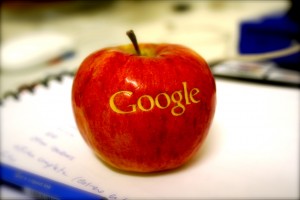
I believe that technology is a process that is ongoing and is hard to define. After all, we consider items like Blackberries and Computers technology, but technology is really everywhere as represented by this article, http://www.cbc.ca/sports/amateur/story/2009/03/14/fina-swimsuits-ruling.html. I love this story because it caused an uproar and made for great talk show fodder. Most people were being overly critical about merging technology with sports, as if this has never happened before.
Technology seems to be constant changing and supposedly attempting to make our lives easier and better. In education this is a double edged sword, which is why I choose this picture. Another reason I chose this picture is because it merges technology and teaching together. Although technology does improve our lives it can also take away. I like this picture because it makes me wonder where we are heading as educators. Are we eventually going to give students a topic, have them Google it and present it as fact? Or is that already what is happening?
September 15, 2009 No Comments
What is Text?
Although we certainly do see and use text on computers and the internet, I wonder if there is something inherently flawed with using this way of viewing text with students. I don’t believe that the text excites students but that the computer that excites students.
A few short months ago I was teaching a primary summer school program. The program was designed for young learners to improve their English writing skills. I decided to have fun one class and have them create their own sentences using stamps. One thing that I noticed, apart from the activity getting really messy, was the excitement that the students had communicating their ideas onto paper using the stamps. There was something in the action of choosing a word, placing the stamp on the ink pad, and seeing their work that that engaged the students far more than a computer activity ever could.
Now is this text that the students created? I think that it is. The students printed their own work on paper, using letters and numbers. It did not matter if the text was coherent or not. Of course, is this the proper way to teach writing skills? However the students received an intriguing lesson and were able to create text manually in an old fashioned way that hopefully enforces the message that there is more than one way to create text.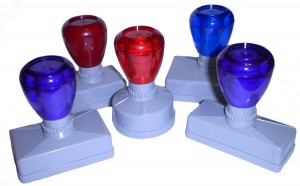
September 15, 2009 1 Comment
Text is a Stimulant

In its most basic state, I see text as something designed to induce a state of mind both when text is created and when it is consumed. Marks are applied to a surface and visually consumed with the intent of inducing an awareness of something else apart from the awareness of the mark itself. That’s an amazing head trip.
Text stimulates us to see our minds reflected back into space and thus, compared to early primal humans, gives us this out of body experience of who we are. To early humans, consuming text would be like taking peyote buttons.
Reference:
Image uploaded by Arenamontanus on 11 Dec 08, 2.00PM PDT on Flickr. Modified by Drew Murphy.
September 15, 2009 1 Comment
Text, Technology, Orality….becomes residual…
Topics/Writing is a drag/ questions from the first module/ personal definitions of Text and Technology, Orality becomes Residual….more questions…
I think we have had an amazing discussion in terms of defining Text and Technology…and Orality… as pointed out in the cambridge session…. someone always objects to a new technology….
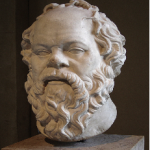
Socrates: Writing is ‘inhuman’
Writing, Socrates argues, is inhuman. It attempts to turn living thoughts dwelling in the human mind into mere objects in the physical world. By causing people to rely on what is written rather than what they are able to think, it weakens the powers of the mind and of memory. True knowledge can only emerge from a relationship between active human minds. And unlike a person, a text can’t respond to a question; it will just keep saying the same thing over and over again, no matter how often it is refuted.
What is Orality? When It becomes….Residual
‘Residual orality’ refers to thought and its verbal expression in cultures that have been exposed to writing and print, but have not fully ‘interiorized’ (in McLuhan’s term) the use of these technologies in their daily lives. As a culture interiorizes the technologies of literacy, the ‘oral residue’ diminishes.
[This information was Retrieved from Wiki Reference: Orality, Sept 14, 2009]
Questions from Module 1:
What is Text? Text to me is synonymous with writing, it also infers content and meaning, that is, text without meaning or letters that don’t form words, would not be “text” but rather just an assemblage of letters, of strokes on a page. Text is meaning, a codification of meaning, but the whole point of text for me is to communicate, communicate what? Communicate meaning.
What is Technology?: means everything that involves technique, that involves a tool, so a pen is a type of writing technology….and language is a kind or technology of orality…etc.
What, for example, does textile have to do with text? Texts are tapestries or weavings of words to create meaning… just as threads are used to create a pattern, letters are used to create a pattern that describes a word, which in turn describes or outlines a meaning….
In the hopes that a visual is in order here….and to layer that onto our discussion, of course all I come up is…more questions…such as…
How is meaning communicated visually?
….Some consider music the highest art form, but just how does music “speak” to us?
How do sounds through speech really communicate meaning?convey Emotion?
Okay I will let the picture do the rest of the speaking here….Barb
September 15, 2009 No Comments
